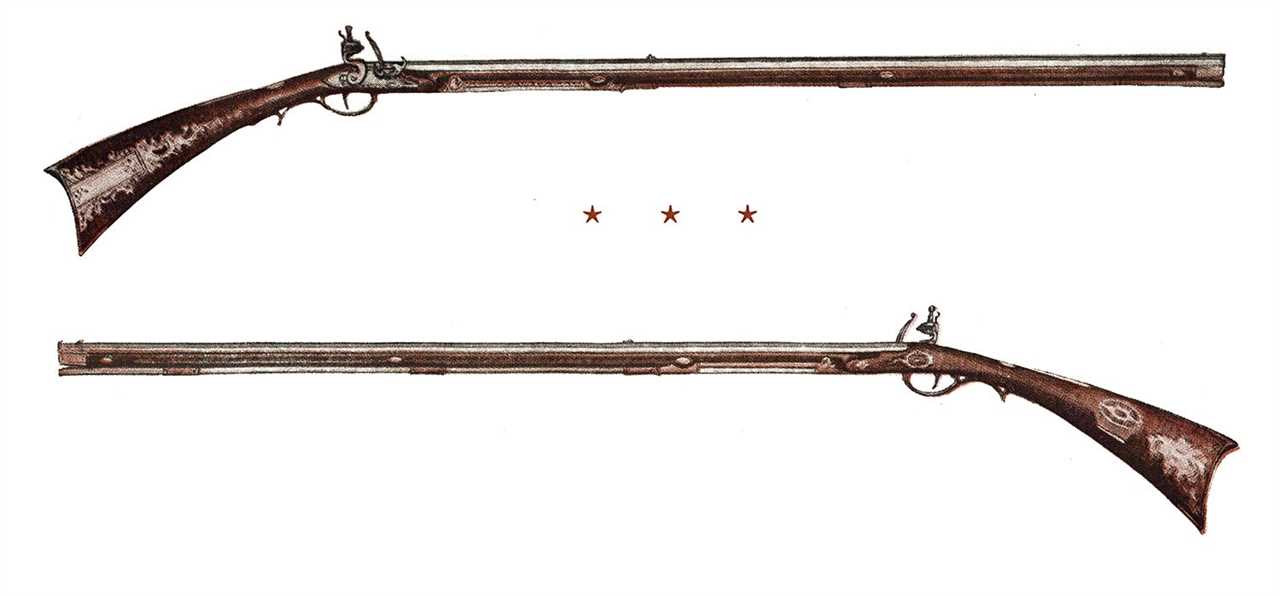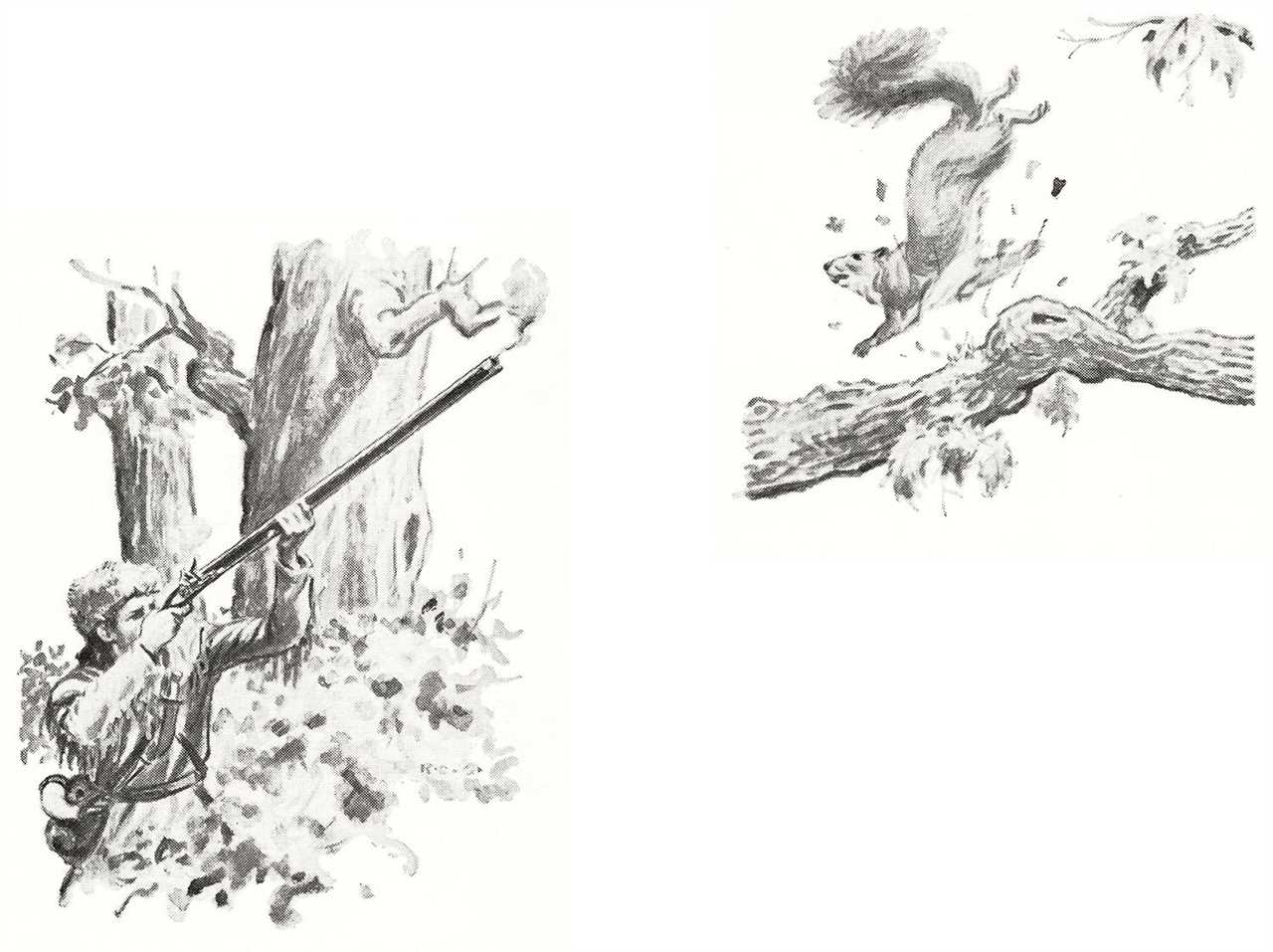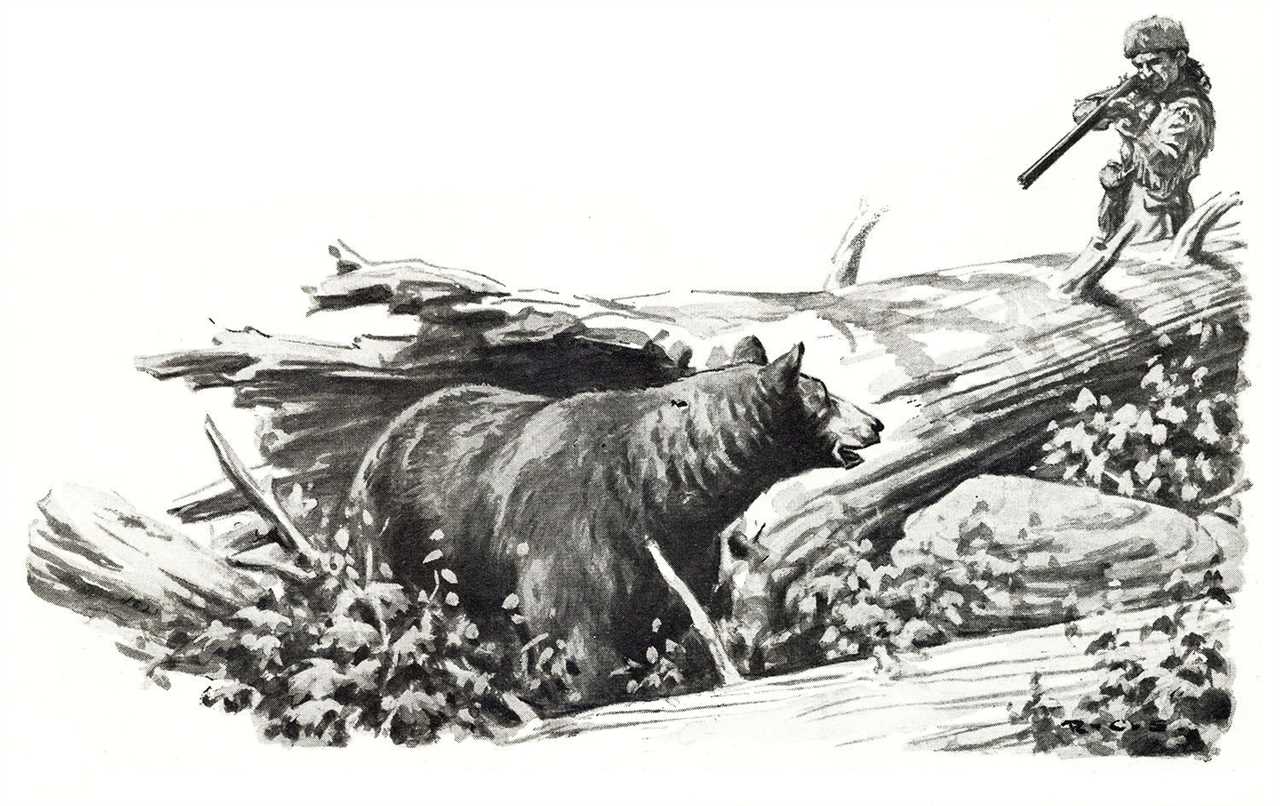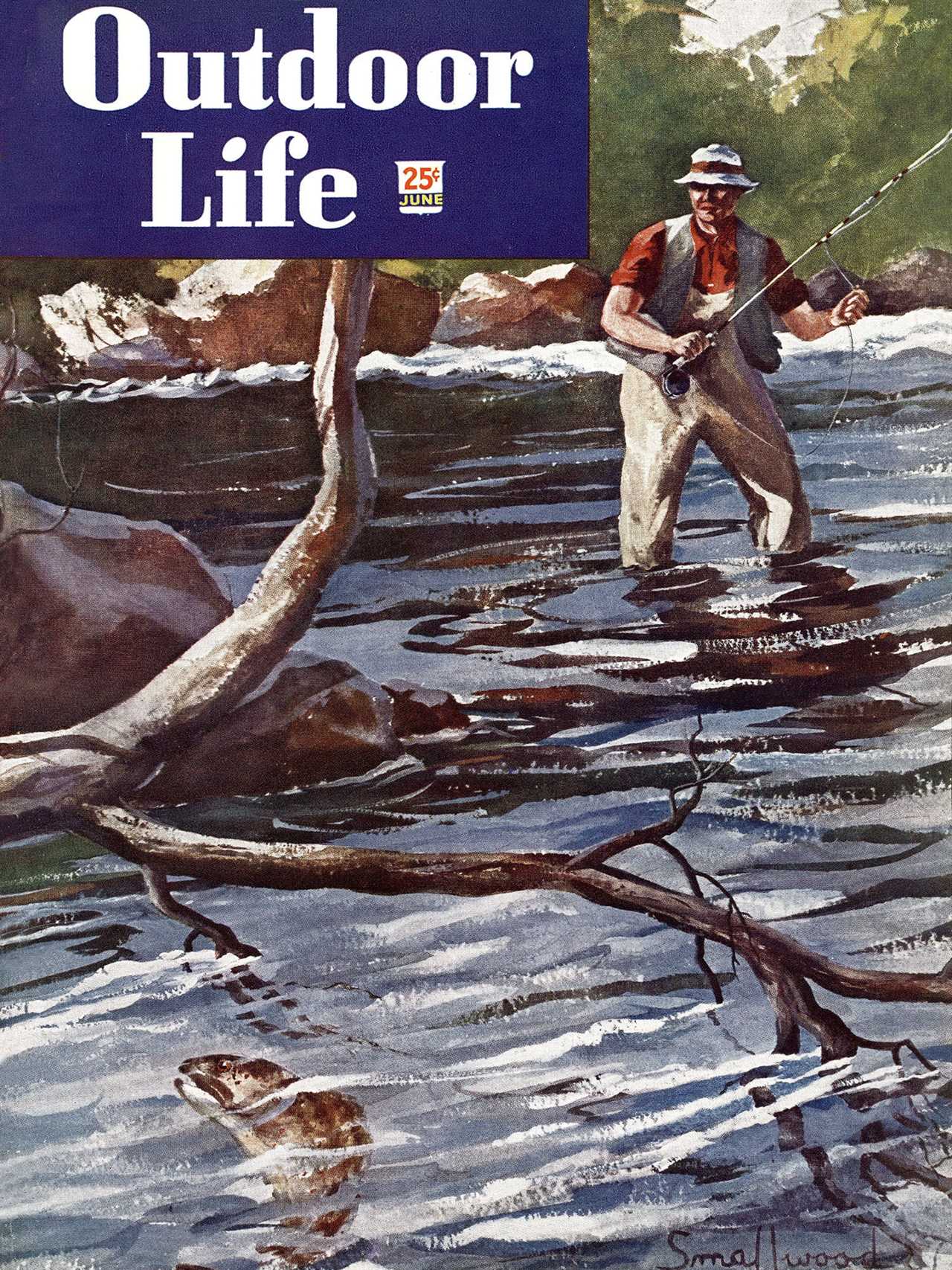The illustration, by Ralph Crosby Smith, that ran with the original story showed a gunsmith rifling a barrel for a Kentucky rifle. The full painting is below. Outdoor Life
We may earn revenue from the products available on this page and participate in affiliate programs. Learn More ›
THE FIRST, and perhaps the most important, truly American firearm was the Kentucky rifle, a weapon which for more than a century was considered the world’s best and chalked up records that still command respect. It was a picturesque arm-long, graceful, and accurate in both hunting and warfare—and its importance in opening large areas of the United States to European settlers cannot be overestimated. Some authorities even say that a long-range hit by a Kentucky rifle may have won the American Revolution!
But before we go into that, let’s take a closer look at the Kentucky rifle itself. In the first place, the name is misleading. The earliest models were made in Pennsylvania for pioneers, many of whom then pushed on into Kentucky—which included all the territory beyond the Cumberland Mountains. Subsequently these weapons were made in small shops as far west as St. Louis, along the Ohio River, and in what are now Pennsylvania, Tennessee, Virginia, the Carolinas—and Kentucky. But many men spoke of their Pennsylvania, not Kentucky, rifles, and certain European firearms authorities still prefer to call them “American rifles.” Then, too, quite a few of these pieces were not rifles but smoothbores, although the majority had either straight or spiral rifling.
Read Next: Photos from Pennsylvania’s Flintlock Season, the Last of Its Kind in the Country
Why was the Kentucky rifle such a success? Probably because here, for the first time, was a firearm that evolved in direct response to America’s needs. Rifles brought over from Europe were of little value in the American wilderness. Loading was a slow, difficult job. The noise of hammering a tight-fitting ball down the length of the barrel often scared off game or attracted attention at the wrong time. Construction was ugly and ungainly; trigger guards were bulky yet frail; sights were useless in dark forests or in any spot where accuracy was vital; calibers were large; and the rifles as a whole were heavy and unreliable. Little wonder that for many years the smoothbores reigned supreme.
That was the state of affairs in the 1720’s when frontiersmen around Lancaster, Pa., began complaining to the newly arrived German and Swiss gunsmiths there. These immigrants were steeped in the traditions of their homelands, where they’d heard even the simple flintlock opposed because the smiths wanted to retain the more expensive wheellock firing mechanism. (The rugged flintlocks sent sparks flying into the flashpan when the trigger was pulled; the wheellock was a fragile spring mechanism which had to be wound in advance.)

This typical Kentucky rifle was made in Pennsylvania by J. Kuntz in the late 1700s. It has an overall length of 59 inches and a 43-inch barrel; caliber is .46. Note the ornamentation. Outdoor Life
It was in response to the demands of obstinate frontiersmen that the famous Kentucky model evolved. It hit its stride by about 1730 but underwent steady change for many years. Most rifles were built to the buyer’s specifications or according to the maker’s latest experiments, and the resulting new ideas were eagerly seized upon by competing smiths. For this reason, surviving examples show wide variations in detail.
No frontiersman wanted to carry a heavy weapon on his long treks in the wilderness. The weight was steadily reduced until the average Kentucky hunting rifle weighed between 9 and 10 pounds. (Those made for match shooting averaged about 19 pounds.) Similarly, using a large-caliber rifle meant that the lone pioneer had to carry a heavy load of bullets. So the caliber was reduced from the .65 and .70 common in Europe to about .45. The pound of lead that once yielded sixteen .70 bullets now gave forty-eight .45 balls—three times as many shots.
Simultaneously the front sight was enlarged and the trigger guard strengthened while it was stripped of its old bulk. But probably the most distinctive change came in the barrel, which on previous rifles had been uniformly short and heavy.
More Barrel, Less Powder
Now it was lengthened, ranging in the early Kentucky models from 51 to 77 inches, or up to more than triple the length of the average big-game rifle of today. This meant that less powder was needed than before, because it burned cleaner. In the opinion of several authorities, this long barrel which gave great accuracy at the same time that it deadened the noise of the firing was the main factor in the success of the Kentucky rifle.
Coupled with this was the novel “patch” method of loading invented by some unsung genius. Thanks largely to this discovery, rifles could be reloaded in one fourth the time it took before, and eventually backwoodsmen were getting off their second shot in less than half a minute after the first.
To patch-load a rifle, you cast the lead-ball bullet in a mold 3/100 of an inch smaller than the actual caliber demanded. In loading, you slipped a piece of dressed buckskin or a bit of old felt hat, about the size of a 50-cent piece and well greased with tallow, under the ball as you held it over the muzzle. Then, when you rammed the ball down the barrel, the greased patch helped it slide along easily, doing away with practically all the old noisy hammering.

Illustration by Ralph Crosby Smith. Outdoor Life
A “Typical” Kentucky Rifle
All these developments didn’t come at once. They were spread over years, but if it were possible to describe a “typical” or composite Kentucky rifle it might be approximately like this:
Its 42-inch barrel, probably full octagon, gave the .45 caliber rifle an overall length of about 55 inches. The stock, which extended to the muzzle, was of curly maple or occasionally cherry—and, in the south, apple wood; the buttplate crescent-shaped, instead of the old straight design. An eight-pointed brass star was sunk in the cheekpiece on the left side of the stock, while in the opposite side was cut a box, trimmed in brass, in which the greased patches were carried. The rifle’s forty-four to fifty parts were handmade and not interchangeable. Many hunting models lacked decorations because these might reflect the sun and frighten game, but other Kentuckys made liberal use of brass on the side plates, buttplate, front sight, rod pipes or thimbles, and trigger guard, as well as on the patch box. Where brass was lacking, German silver or iron was substituted.
Although the early locks (firing mechanisms) were homemade, most of the later models were imported from Germany or England. The British usually supplied the flints, which sold for 2 cents each and were good for fifty shots.
To give a stock an artificial grain, the maker wound tarred string around and around the wood and burned it off. Soot and oil were rubbed in to stain the wood, and some stocks were treated with a special oil varnish. All in all, the Kentucky rifle—some models of which reportedly sold for $12 to $14 against $125 for a fancy European sporting smoothbore—was made to give lasting satisfaction.
However, exposure, rust, and the constant wear and tear of the split-hickory ramrod forced many owners to return their rifles to the smith for “freshing” or enlarging the caliber. This meant the hunter had to use larger patches or ream out his mold to cast bigger bullets. Still other worn rifles were refinished with smooth bores.

It took a good eye to “bark” squirrels. Shock killed or stunned the bushy-tail. Illustration by Ralph Crosby Smith. Outdoor Life
Although legend would have us believe that every frontiersman was a crack shot, and many of them doubtless were top-notchers, some users of the Kentucky rifle were away below par. That helps account for the popularity of Kentuckys with straight-cut rifling. These made good combination arms. They’d fire two lead balls at once, much as the smoothbore could, or even handle loads of BB to No. 4 shot. Yet they’d fire a single patch and ball accurately enough to bag big game. Some hunters even used mixed loads—a scattering of shot on top of a lead ball—when out for fox or turkey.
The Kentucky’s flintlock firing mechanism and the bullet mold also had incidental uses. You could start a fire by placing a tiny wad of unspun flax in the flashpan and sprinkling it with powder. When you pulled the trigger, sparks fell on the wad and started it burning. Just drop this into a little pile of dry tinder, and presto—a fire!
Sinkers From Bullet Molds
Bullet molds were made of brass, stone, and even from old curling irons. They resembled pliers, with a hollow in one jaw to shape the bullet. Anglers of the day used them to cast weights for fish nets and seines.
Powderhorns were carved with scenes, family histories, and maps. They were often scraped so thin that the black powder showed through, giving the hunter a constant check on his supply. The average Kentucky rifleman’s horn was some 11 inches in length and held up to 4 pound of powder. Much smaller was the priming-powder horn, which was carried in the pocket or in the hunting bag slung by a strap around the neck. This bag also contained a wire for cleaning the touchhole (through which the priming powder ignited the coarse powder and fired the rifle), flints, a few light tools, a bone needle for repairing ripped clothing, and extra bullets.
Many Kinds of Sights
Plain open sights were preferred by the early hunters—some type of notch, say, for the rear with a post or a fin in front. Rear sights were placed on grooved slides, and horizontal adjustments were possible. Most frontiersmen sighted in their rifles to shoot a bit high at 50 yards. The ball reached its peak height between 50 and 100 yards; at 100 yards it registered a 3-inch drop.
Pinhead front sights—much like the modern bead sights—were standard for match shooting, but all sorts of rear sights, including peep sights, were used. Many marksmen swore by a long brass or iron tube, up to 5/8 inch in diameter and extending the full length of the barrel. It was possible to make horizontal adjustments on this because it was clamped at each end to a sliding base. A peephole in the eyecup and a pinhead front sight, fixed slightly below point-blank range, completed the setup. Users claimed clearer definition of their targets and some experts say that these were the sights Congress had in mind when it ordered the purchase of telescopes for use on rifles during the Revolution.
American pioneers who grew up with the Kentucky rifle in their hands were real riflemen. As hunters, they were silent, swift, and deadly; as target shooters they were cool, self-confident, and accurate. And don’t forget their womenfolk, some of whom could match their husbands shot for shot. The wife of one gunsmith was acknowledged to be better than any rifleman in the area. It was her job to test each rifle made by her husband. And many a self-reliant frontiersman, who balked at resting a rifle barrel on a handy prop for an ordinary shot, was glad to support it on his wife’s shoulder for a difficult long-range target.

To lure a bear from a hollow log, the hunter would tap on the wood until the bruin came out to investigate. Illustration by Ralph Crosby Smith. Outdoor Life
To judge wind velocity, these men watched the fluttering of the leaves. They knew many little tricks, including a few that had been handed down for several generations. One of these, the practice of stalking big game while hidden beside a horse, had been used by archers in Europe hundreds of years before. Another was coaxing a bear from his hiding place in a big log by sneaking up silently and tapping at intervals on the wood. Pretty soon the nosy bruin would clamber out to investigate—just in time to be shot.
If his dog treed smaller game at night, the backwoodsman had no hesitation in climbing the tree and shaking the animal to the ground. If he wanted a change of diet, he could use his Kentucky rifle to shoot large fish! And to lure gobblers, he made a call from a turkey-wing bone.
Turkey Shoots Were Fun
A hunter needed all the practice he could get if he planned to enter a regular turkey shoot. Ranges depended on how much of the turkey was visible. If only the neck and head could be seen when the bird peered over a bulletproof plank, the range was shorter than if the entire bird was tied out in plain sight.
Many shooting matches were held in the woods, with squirrels as the targets; a natural form of competition, since nearly all these men shot bushy-tails year in and year out. (Using a Kentucky rifle, a modern Tennessee gunsmith, William Walker, is said to have shot forty squirrels without a miss in a shooting match with a rival marksman.)
From Kentucky-rifle days come the picturesque stories about “barking” squirrels, a stunt which Daniel Boone is said to have been one of the first to perform. The trick was to hit the bark of the tree directly under the squirrel. When this was done properly, the bark was splintered and the squirrel, killed or stunned by the concussion, was sent flying head over heels through the air. Try it with your .22!

The June 1948 cover featured a painting of a trout-fishing scene by Kenneth A. Smallwood. Outdoor Life
Washington Asked for Riflemen
George Washington had learned the value of Kentucky riflemen in the French and Indian War. When the Revolution began, he urged the Continental Congress to put in a call for them. So it happens that the first troops raised by a central government on this continent were companies of straight-shooting backwoodsmen—and this might be called the beginning of the U. S. Army!
From the far fringes of the frontier the colorful, independent hunters flocked to their meeting places. One group of ninety-six men, recruited in Virginia by Daniel Morgan, marched 600 miles in 21 days to join the army facing the British at Cambridge, Mass. And some of these tough customers had walked 200 miles through the wilderness in order to enlist!
The bulk of the fighting in the Revolution was done with smoothbore muskets, so inaccurate that nineteen shots out of twenty would miss an 18-foot-square target at 350 yards. This performance was so poor that Benjamin Franklin urged the authorities to equip the Continental Army with bows and arrows.
Like every other improvement in arms, from the longbow to the atom bomb, the rifle was denounced as barbarous and uncivilized—by the side that didn’t have it. After Bunker Hill, the British tried to alibi their heavy losses by charging that the Americans used rifles with slit bullets that broke in four parts when fired. As a matter of fact, the frontier riflemen hadn’t arrived at the time of Bunker Hill; according to a writer of the time, the New England farmers who fought there were armed with muskets, mostly without bayonets. But he adds: “They are almost all marksmen, being accustomed to sporting of one kind or another from their youth.”
Soon, however, the men with the Kentuckys were pouring northward, amazing townspeople with their marksmanship as well as with their outlandish garb and swaggering manners. Newspapers were filled with stories of their feats—many of which obviously gained in the telling. From Lancaster, Pa., a townsman wrote of seeing a man take a 5 x 7-inch piece of board and hold it between his knees while his brother put eight bullets through it in succession from a distance of 60 yards. Another chap offered to shoot an apple off a man’s head at the same range, but the timid spectators declined to watch any such fool stunt.
After they joined the army at Cambridge, the backwoodsmen made life miserable for the British. Their specialty was picking off officers and sentries. Soon a Philadelphia printer was writing to a friend in London: “This province has raised 1,000 riflemen, the worst of whom will put a ball into a man’s head at the distance of 150 or 200 yards. Therefore advise your officers who shall hereafter come out to America to settle their affairs in England before their departure.”
Like every other improvement in arms, from the longbow to the atom bomb, the rifle was denounced as barbarous and uncivilized—by the side that didn’t have it.
British General Howe is said to have offered a large reward for the capture of a Kentucky rifleman. When one finally was taken, Howe sent him to London to show what the redcoats were up against. A few demonstrations of his skill brought British enlistments practically to zero!
The riflemen may have overdone their long-range shooting, however. Some American officers seemed to feel that by attempting too many “preposterous” shots the backwoodsmen were wasting ammunition and getting so many misses that it might lessen the wholesome respect the British had for them. So one outfit was given strict orders not to fire at any target more than 150 yards away.
The shot that may have won independence was fired by Daniel Murphy, a frontiersman with Morgan’s outfit. At a critical moment in the Battle of Saratoga, according to the story, Murphy was ordered to pick off the British General Fraser, who was rallying the redcoats.
Fraser was standing with two aides on a hill 300 yards from Murphy’s position. The backwoodsman calmly loaded, sighted his long-barreled Kentucky rifle, and fired. One of the aides fell. Murphy loaded and fired again—and missed. By this time Fraser knew he was being shot at, but his code of honor forced him to stay where he was. At the third shot he fell, dead. Some historians say that his death decided the battle, which in turn influenced the French to intervene and so made independence sure.
Just how good was the Kentucky rifle? Fortunately, we don’t have to try to sift fact from fancy in the legends of frontier marksmanship. Modern firearms collectors have actually tried out the old flintlocks in hunting and target work, and have tested their ballistics by scientific methods.
The results of one of these tests are reported by Townsend Whelen in his book, The American Rifle. The arm was a Rosser flintlock made in Lancaster, Pa., in 1739. It fired a round ball of .32-inch diameter weighing 49 grains, with a charge of 22 grains of black powder. The test was made at the Remington-Union Metallic Cartridge Co. factory, and here’s how the old gun showed up:
- Muzzle velocity: 1,483 foot seconds
- Muzzle energy: 239 foot pounds
- Velocity at 100 yards: 850 foot seconds
- Energy at 100 yards: 79 foot pounds
- Velocity at 200 yards: 617 foot seconds
- Energy at 200 yards: 41 foot pounds
According to Whelen, the best range for rifles of this type was about 60 yards. They were seldom used, he says, at more than 100 yards, and beyond 150 yards were not reliable. In power he classes them with the present-day .25 Stevens rimfire cartridge at short ranges.
A slightly more flattering picture was given in hunting and target tests made by Capt. John G. W. Dillin, collector and authority on Kentucky rifles. In 1921 Dillin took a famous flintlock called “Old Killdeer” to a farm and had “a well-known offhand rifleman” try it out.
The first targets were pigeons sitting on a high barn, 30 to 35 yards away. Two birds were killed in three shots. What is more, the rifleman called his shots: “High up, as I aimed above the center of the body.” On the same trip, three starlings and a sparrow were hit at 15 to 40 yards—a total of six dead birds for eight shots, strictly offhand.
Another time, Dillin took “a good flintlock” to Ontario and tried it on wild ducks. Out of three shots at ducks swimming 150 yards away, he hit one bird squarely through the body, another in the wing. The miss was the first shot and was due to overestimating the drop of the bullet.
With Walter M. Cline, of Tennessee, Dillin tested three Kentucky rifles (a spiral-groove, a straight-cut, and a smoothbore) on standard silhouette targets the size of an average man. Out of ten shots at 300 yards, the spiral scored five hits, the straight-cut two, and the smoothbore one hit. Beyond 300 yards, Dillin reported, the percentage of hits was small.
Kentuckys Still in Use
While these cold figures demolish some of the tall stories of frontier legend, the fact remains that the Kentucky rifle was a great firearm for its day. Compared with the best sporting and military arms of the time, it represented nothing less than a revolution in its field.
Some flintlock Kentucky rifles are still in use today, mostly for target shooting by muzzle-loader enthusiasts, but for all practical purposes this famous arm faded from the picture about the year 1830.
Many specimens were refitted to handle percussion caps when these appeared. Calibers were reduced and barrels were shortened. However, men moving west found this rifle unsuited for use on horseback, and new weapons began to appear.
But still the Kentucky rifle lives in memory and tradition—a truly American, a truly great weapon, worthy of the men who used it.
This story was originally published in the June 1948 issue of Outdoor Life under the title “Fabulous Firearm: The Kentucky Rifle.” The text been minimally edited to meet contemporary standards.
Read more OL+ stories.
The post Why Was the Legendary Kentucky Rifle Such a Success? appeared first on Outdoor Life.
Articles may contain affiliate links which enable us to share in the revenue of any purchases made.
By: Fred R. Zepp
Title: Why Was the Legendary Kentucky Rifle Such a Success?
Sourced From: www.outdoorlife.com/guns/history-kentucky-rifle/
Published Date: Mon, 24 Apr 2023 14:37:51 +0000
----------------------------------------------
 Backyard GrillingWeekend WarriorsAdvice from DadBeard GroomingTV Shows for Guys4x4 Off-Road CarsMens FashionSports NewsAncient Archeology World NewsPrivacy PolicyTerms And Conditions
Backyard GrillingWeekend WarriorsAdvice from DadBeard GroomingTV Shows for Guys4x4 Off-Road CarsMens FashionSports NewsAncient Archeology World NewsPrivacy PolicyTerms And Conditions
